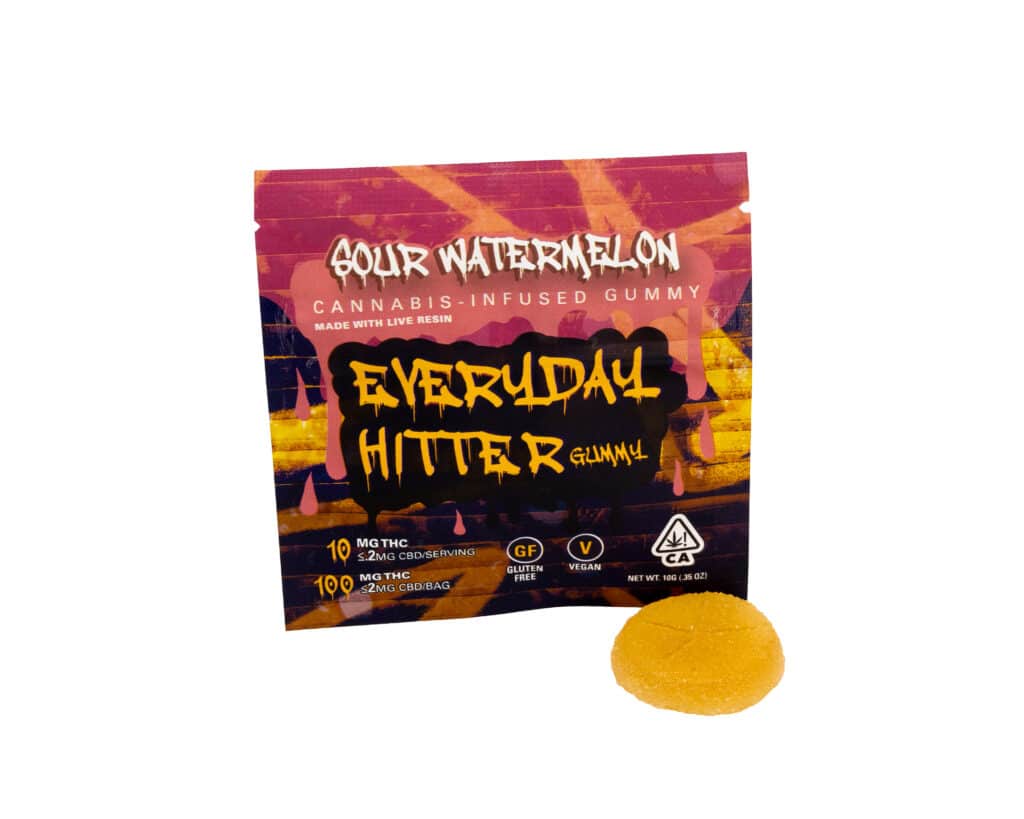
 Cannabis edibles are most often regulated by, and thus marketed by, their THC content. In most taxed and regulated cannabis markets, this number is typically limited both by serving size and by the total available in the entire package. Here in California, for example, cannabis edibles sold in licensed dispensaries cannot contain more than 10mg of THC per serving, and no more than 100mg of THC in the entire package. This is why it is so common to see products come as ten gummies at 10mg per piece.
Cannabis edibles are most often regulated by, and thus marketed by, their THC content. In most taxed and regulated cannabis markets, this number is typically limited both by serving size and by the total available in the entire package. Here in California, for example, cannabis edibles sold in licensed dispensaries cannot contain more than 10mg of THC per serving, and no more than 100mg of THC in the entire package. This is why it is so common to see products come as ten gummies at 10mg per piece.

With such a strict cap in place for cannabis edibles in California, and other taxed and regulated markets, brands can mix up their style of treats and offer new flavors but aren’t the effects all the same? Isn’t 10mg of THC the same, regardless of what brand or product you eat?
Not exactly, it turns out. And as with so many other enlightening aspects of cannabis, so far anecdotal evidence from stoners like you and me has a huge head start on lab-grade research.
Yes, it is true that “THC is THC”, but as many of us know and as more custies are learning, THC is just part of the equation for those seeking the so-called ‘entourage effect’ that only occurs when a broad or full spectrum of cannabinoids, terpenes, and other essential cannabis compounds come together to deliver it.
With that in mind, a fair question to ask any cannabis edibles brand is, “What are the active ingredients in your products and where do they come from?”
EXTRACTION METHODS USED TO CREATE CANNABIS EDIBLES
A growing trend in cannabis edibles packaging here in Cali is for the brand to tell the customer what style of extraction was used to create the concentrated cannabis oil that gives their product its kick. That is if that extraction method is seen as a selling point.
On a commercial scale, there are really only a handful of viable extraction methods that will allow an overburdened cannabis brand to remain consistent and compliant with every batch they make while remaining even close to cost-efficient.
Roughly speaking, you’ve got hydrocarbon extraction, solventless extraction, and distillate.
Breaking it down a bit further, hydrocarbon extraction could entail anything from FECO (Full Extract Cannabis Oil) like “Rick Simpson Oil”, to various forms of propane or butane-based extraction of either dried, cured buds and trim, or fresh frozen live buds and trim used to create ‘live resin’.
‘Solventless’ extraction methods use ice and water instead of butane or propane, creating a traditional hash that is further processed into what the market now knows as ‘rosin’ – not to be confused with ‘resin’. As in the description above, if the buds and trim are freshly frozen right at harvest, the final product in this whole process can then be called ‘live rosin’. Also like hydrocarbon extractions, it is fair to consider live rosin as a full spectrum extract, rich in cannabinoids, terpenes, flavonoids, and the rest.
Distillate is a highly refined form of what was once crude cannabis oil. Now stripped of all flavor and most of its cannabinoid profile, cannabis distillate can consistently provide high THC totals at a low price, which makes it an ideal active ingredient for some budget-wary brands.
Clearly, both live resin and live rosin require some extra steps and care to be taken from harvest time all the way through production. These products, in dab form, tend to fetch a higher price than their “cured” counterparts.
RELATED READING: Facts vs. Fiction – Can I Overdose on Cannabis Edibles?
Another consideration is that cannabis in general and cannabinoids specifically don’t taste very good in their natural forms. Distillate, on the other hand, is not only cheaper to produce and acquire, but it also has little or no flavor. Upgrading your active ingredient makes it trickier and costlier to mask that overpowering weed flavor if that is a priority.
So, naturally, if higher cost/higher quality ‘live’ resin and rosin are used as the “main” ingredient in a cannabis edible product, those brands are more likely to mention that prominently on their packaging.


But does it matter, ultimately, to the average consumer?
Do different extraction methods produce different effects from cannabis edibles?
Researchers have a lot of catching up to do before they’ll be publishing any peer-reviewed studies about the effects of extract type in an edible, but basic weed science tells us that different extraction methods produce different chemical profiles.
When it comes to a product like vape cartridges, would anyone argue that puffing on a cart full of disty will deliver a different effect than a cart full of legit live resin?
Why, then, would we assume it wouldn’t matter with edibles?
That racy high and quick crash from distillate tends, in my experience, to carry over to distillate-based edibles or drinks.
Edibles that are fueled by a broader – or ideally FULL – spectrum of cannabinoids, terps, etc. tend to put me out comfortably for 7-8 hours of great sleep with no ‘hangover’ in the morning. That is why I consume edibles, so that makes it easy to narrow down my possible purchases.
Personally, I have found that ‘live rosin’ based edibles tend to cater (pun intended) to the more “health conscious” crowd, and are more likely to highlight their natural cannabis flavor instead of masking it behind artificial flavorings. I don’t mind that natural weed flavor at all, but I have found that I need to take roughly 1.5x the dose compared to when I consume hydrocarbon extraction-based edibles, which to me still reign supreme when coming from a trusted source.
In the end, as with nearly all things cannabis, this is a personal preference and a personal journey that led me to it.
Enjoy the journey.
















